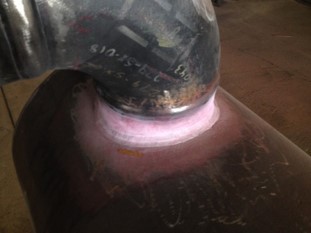Liquid Penetrant Testing for Welding Joint
Liquid penetrant testing for welding joint is done based on approved procedure and by qualified ASNT Level II or Level III inspectors. The liquid penetrant testing can reveal open-surface welding defect only.
There are the different types of liquid penetrant test that can be conducted on the welding joint such as visible liquid penetrant testing and when higher sensitivity needed, then fluorescent liquid penetrant test technique might be used.

Some test procedures require that the liquid penetrant test be performed after the first pass in the groove weld to ensure no solifidaction crack created. If any crack found in the first pass, then it will be removed by grinding, and root pass is re-welded.
Sometimes it is required that the liquid penetrant test being performed before back welding in groove welds. In this case, after completion of the welding (all passes), the other side will be subjected to the chipping /grinding and back welding.
In the first step, the back chipping is conducted and then is subjected to the liquid penetrant test, if no crack or any other discontinuity found, then back welding will be performed.
Liquid penetrant testing for welding joint - Reveal Cold Cracking or delayed cracking
This kind of crack happens in high strength carbon steel. The crack is caused by diffused hydrogen in the weld metal. The crack typically happens two or three days after welding. The liquid penetrant test will be effective if be performed few days after welding.
This crack might also happen in heat affected zone (HAZ). So the liquid penetrant testing should also cover the weld seams adjacent area as well. The HAZ wide depends on material thickness and heat input (during the welding). However, can be considered 2 to 3 times of the material thickness from each side of the weld seam.
Liquid Penetrant Testing for Welding Joint - Detecting Hot Cracking
The crater crack (happens at the end of weld), solidification cracking and shrinkage cracking are considered hot cracking. The liquid penetrant test can be done as soon as the welding completed and temperature decreased to the 50 to 125 F.
Lack of Fusion (LOF)
The lack of fusion happens when deposited weld metal does not make bond completely with the material. The LOF can be detected by liquid penetrant test if this disbondment is on the surface.
The side wall lack of fusion and lack of fusion between weld passes cannot be revealed with this method, and Ultrasonic or Radiography testing might be applied.
Surface Porosity
Surface porosity also can be detected by liquid penetrant testing, and it is caused by trapped gas inside of the weld metal.
The liquid penetrant testing also is used to detect in-service cracking that is caused by stress corrosion cracking and fatigue cracking.
Free newsletter!
Sign up to receive my monthly newsletter covering all the latest courses and updates.




New! Comments
Have your say about what you just read! Leave me a comment in the box below.